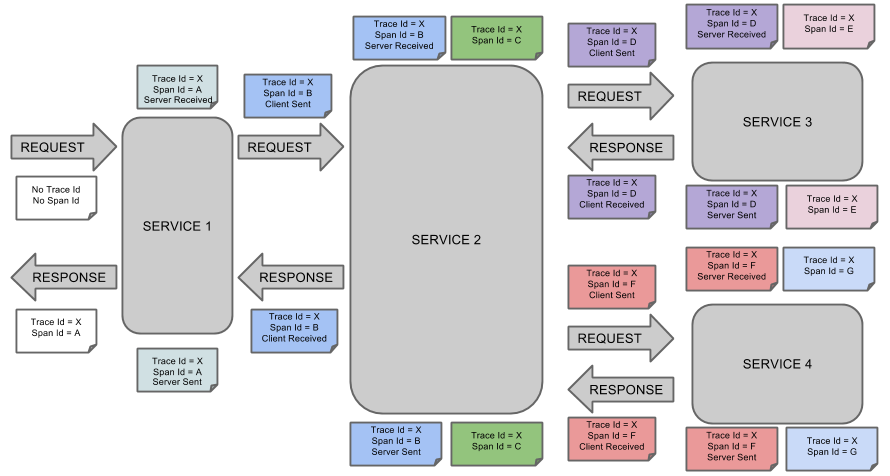Spring Cloud Sleuth
Spring Cloud Sleuth为Spring Cloud实现了分布式跟踪解决方案
相关术语
Span(跨度): 工作的基本单位。例如,发送RPC是一个新的跨度,就像发送响应到RPC一样。 Span是由一个唯一的64位ID来标识的,而另一个64位ID用于跟踪。 span还具有其他数据,如描述、时间戳事件、键值标注(标记)、导致它们的span的ID和进程ID(通常是IP地址)
可以启动和停止跨度,并跟踪其时间信息。 创建跨度后,必须在将来的某个时刻停止它。
启动跟踪的初始范围称为根跨度。 该范围的ID值等于跟踪ID。
Trace(痕迹): 一组span形成树状结构。 例如,如果运行分布式大数据存储,则可能由PUT请求形成跟踪
Annotation(注解): 用于及时记录存在的事件。常用的Annotation如下
- cs(client send):客户已发送。客户提出了请求。此注释表示Span的开始
- sr(Server Received):服务器收到;服务器端获得请求并开始处理它。从此时间戳中减去cs时间戳会显示网络延迟
- ss(server send):服务器已发送;在完成请求处理时(当响应被发送回客户端时)注释。从此时间戳中减去sr时间戳会显示服务器端处理请求所需的时间
- cr(client received):客户收到了;表示跨度的结束。客户端已成功收到服务器端的响应。从此时间戳中减去cs时间戳会显示客户端从服务器接收响应所需的全部时间。
下图显示了Span和Trace在系统中的外观以及Zipkin注释:

注释的每种颜色表示跨度(有七个跨度 - 从A到G)。 请考虑以下注释:
Trace Id = X
Span Id = D
Client Sent
此注释表示当前跨度的Trace Id设置为X,Span Id设置为D.此外,还发生了Client Sent事件。
下图显示了跨度的父子关系:

为项目添加Sleuth
有两种模式第一种是只有Sleuth。另一种是with Zipkin via HTTP
Only Sleuth (log correlation)
<dependencyManagement>
<dependencies>
<dependency>
<groupId>org.springframework.cloud</groupId>
<artifactId>spring-cloud-dependencies</artifactId>
<version>${release.train.version}</version>
<type>pom</type>
<scope>import</scope>
</dependency>
</dependencies>
</dependencyManagement>
<dependency>
<groupId>org.springframework.cloud</groupId>
<artifactId>spring-cloud-starter-sleuth</artifactId>
</dependency>
- We recommend that you add the dependency management through the Spring BOM so that you need not manage versions yourself.
- Add the dependency to spring-cloud-starter-sleuth.
Sleuth with Zipkin via HTTP
<dependencyManagement>
<dependencies>
<dependency>
<groupId>org.springframework.cloud</groupId>
<artifactId>spring-cloud-dependencies</artifactId>
<version>${release.train.version}</version>
<type>pom</type>
<scope>import</scope>
</dependency>
</dependencies>
</dependencyManagement>
<dependency>
<groupId>org.springframework.cloud</groupId>
<artifactId>spring-cloud-starter-zipkin</artifactId>
</dependency>
We recommend that you add the dependency management through the Spring BOM so that you need not manage versions yourself.
Add the dependency to spring-cloud-starter-zipkin.